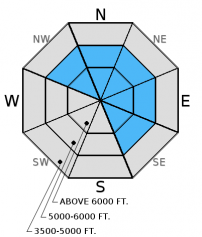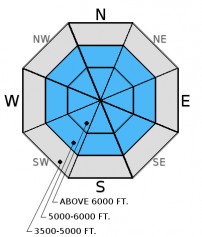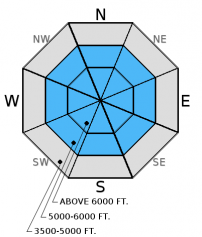| Sunday | Sunday Night | Monday | |
|---|---|---|---|
| Cloud Cover: | Snow showers. | Decreasing snow showers. | High pressure building. |
| Temperatures: | 27-35 deg. F. | 15-23 deg. F. | 25-35 deg. F. |
| Wind Direction: | W-SW | W | W-SW |
| Wind Speed: | 8-11 gusts 21-23 | 6-8 gusts 18 | 7-9 gusts 21 |
| Snowfall: | 1-3 in. | 0 in. | 0 in. |
| Snow Line: |
Whitefish Range
Swan Range
Flathead Range and Glacier National Park
How to read the forecast
Both human triggered and natural avalanches were recently observed. Though natural activity should decrease, our current snowpack is widely variable and backcountry travel is tricky and dangerous. The avalanche danger is CONSIDERABLE above 5000 feet and MODERATE below 5000 feet. Careful snowpack evaluation, cautious route-finding, and conservative decision making are essential. An avalanche fatality occured in the area yesterday, more information below.

3. Considerable
?
Above 6500 ft.
3. Considerable
?
5000-6500 ft.
2. Moderate
?
3500-5000 ft.
- 1. Low
- 2. Moderate
- 3. Considerable
- 4. High
- 5. Extreme
-
Type ?
-
Aspect/Elevation ?

-
Likelihood ?CertainVery LikelyLikelyPossible
 Unlikely
Unlikely -
Size ?HistoricVery LargeLargeSmall

Recent strong winds at upper elevations loaded leeward slopes and cross-loaded terrain features like rock outcrops, tree islands, and spur ridges at mid elevations (photo). Wind slabs formed on smooth crusts may take longer to strengthen. Additionally, wind drifted snow adds weight to the snowpack just like new snow, and can stress existing weak layers that may fail deeper and propagate wider. Look for smooth, rounded features on the snow surface or deeper looking pillows. Carefully evaluate recently wind loaded terrain before committing to a slope.
-
Type ?
-
Aspect/Elevation ?

-
Likelihood ?CertainVery LikelyLikelyPossible
 Unlikely
Unlikely -
Size ?HistoricVery LargeLargeSmall

There is a lot of variability across the advisory area with this problem that warrants careful snowpack evaluation and cautious route-finding. Buried surface hoar and weak faceted snow exist in all ranges, but you won't find them on all slopes and they vary in reactivity. A rain crust that formed on January 12 has become less reactive, but weak, faceted snow started to form around this layer and it should not be shrugged off. Also, another crust formed on January 17 has been more isolated in distribution, but reactive in stability tests. This layer is potentially the culprit of several recent natural avalanches. These weak layers are now 2 to 4.5 feet deep after the recent series of storms. The obvious signs of instability have mostly diminished, but that does not imply stability. Given the tricky distribution of these persistent slabs it would be wise to avoid steep, open slopes and convexities. The only way to know if these layers are reactive is to dig into the snow and perform stability tests.
-
Type ?
-
Aspect/Elevation ?

-
Likelihood ?CertainVery LikelyLikelyPossible
 Unlikely
Unlikely -
Size ?HistoricVery LargeLargeSmall

Several days with small amounts of dense snow created thin storm slabs that may become reactive with additional loading today. Pay attention to these unsettled slabs particularly when traveling in and around terrain traps. Remember that a small slide can affect deeper weak layers and potentially step down triggering a more dangerous avalanche.
We are deeply saddened to report that a snomobiler died in an avalanche accident in the Swede Creek area in the Whitefish Range on Saturday, 1/23/2016. We extend our most sincere condolences and our thoughts are with the family, friends, and those involved. We don't know details yet, and our staff is headed to the site Sunday to complete an avalanche accident investigation. We will provide an update as soon as more details emerge.
A pilot flying over the area yesterday reported a large avalanche that likely occured Friday on a south facing slope near Mcginnis Creek in the southern Whitefish Range.
Yesterday Erich was instructing a level 1 class in the southern Whitefish Range. They observed 4 recent avalanches in Canyon Creek (2 of them size D-2 and 2 were D 1-1.5) also thought to have slid on Friday. They noted variable results in stability tests on east, south, and west aspects. With hard force the January 17 crust fractured and propagated. They also were able to get the January 12 crust to fracture with hard force in compression tests. They noted clean, quality 1 shears on this layer. No other obvious signs of instability were observed. Mark and Guy were in the Wahoo drainage in the Flathead Range and found a new breakable crust on the surface. The January 17 rain crust was not present in this location (observation).
Two seperate parties of skiers were the Dickey drainage and Essex Mountain both in the Flathead Range. They also found a breakable crust 1-2 inches thick on the surface up to 6000 feet. They did not observe any obvious signs of instability. Skiers on Hellroaring peak in the southern Whitefish Range did not observe a surface crust, but found a firm, wind affected surface.
Friday, BNSF Avalanche Safety reported several natural avalanches in their program area. Visibility was limited, but the avalanches appeared to be loose, wet.
We were in the Red Meadow area in the northern Whitefish Range on Friday. Warm temperatures at low to mid elevations began to moisten the snow surface early in the day. We noted roller balls, tree bombs, and small, loose, wet avalanches in these elevation bands. Below 6000 feet the warm temperatures formed a more cohesive recent storm layer that slid on the January 17 rain crust along steep gully walls while skiing out (Photo). We found the January 12 and January 17th rain crusts that were buried 1-2 feet deep with weak, faceted snow forming around them.
Two separate skiing parties near Essex in the Flathead Range on Thursday reported reactive layers 2-3 feet from the surface in their stability tests . Their tests showed these layers fracturing and propagating (observations) in Extended Column Tests. In the southern Whitefish Range we noted active wind loading from moderate southerly wind. Skiers on Patrol Ridge in the Flathead Range found instability in recent storm snow as well as buried surface hoar that was reactive in stability testing (observation).
On Hash Mountain in the Lost Johnny drainage in the Swan Range on Wednesday, we were able to easily trigger three wind slabs on northerly aspects from the safety of the ridge above. All slabs were about 12-14 inches deep and propagated wide across each slope (video and observation). In our stability tests, the layer of facets and surface hoar below the 1/12 rain crust fractured and propagated as well (observation). We also observed a small natural avalanche at about 5200 feet that likely occurred within the past 24 hours (photo).
Also on Wednesday, a couple of skiing parties just outside the boundary of Whitefish Mountain Resort reported triggering a wind slab on a north aspect up to 16 inches deep (observation), and no one was caught.
Visit our Observations page and our You Tube channel for more observations from the entire season.
Thanks to everyone for submitting observations. They are extremely useful and could help save lives.
HOW TO SUBMIT OBSERVATIONS:
Email: [email protected]
Call and leave a message: 406.387.3821
You can also submit quick observations via text: 406.241.4571 (FAC mobile)
OR
Submit Snowpack Observations: http://www.flatheadavalanche.org/node/add/snowobs
Submit Avalanche Observations: http://www.flatheadavalanche.org/node/add/avyobs
Temperatures remained mild and another 2-4 inches of snow fell in the last 24 hours. Winds moderated a bit and were 5-10 mph out of the west and southwest with gusts from 10-20 mph. Currently, temperatures above 6000 feet range from 24º-30º F and winds are west-southwest at 7-9 mph with gusts from 12-18 mph. For today, expect light snow to continue and decrease this evening. Temperatures will rise to the upper 20s - low 30s, and winds will move out of the west and southwest at 5-15 mph with ridge top gusts in the 20s.
| 0600 temperature: | 24-30 deg. F. |
| Max. temperature in the last 24 hours: | 27-35 deg. F. |
| Average wind direction during the last 24 hours: | WSW |
| Average wind speed during the last 24 hours: | 5-10 mph |
| Maximum wind gust in the last 24 hours: | 10-20 mph |
| New snowfall in the last 24 hours: | 2-4 inches |
| Total snow depth: | 59-84 inches |
This advisory applies only to backcountry areas outside established ski area boundaries. This advisory describes general avalanche conditions and local variations always occur. This advisory expires at midnight on the posted day unless otherwise noted. The information in this advisory is provided by the USDA Forest Service who is solely responsible for its content.









































